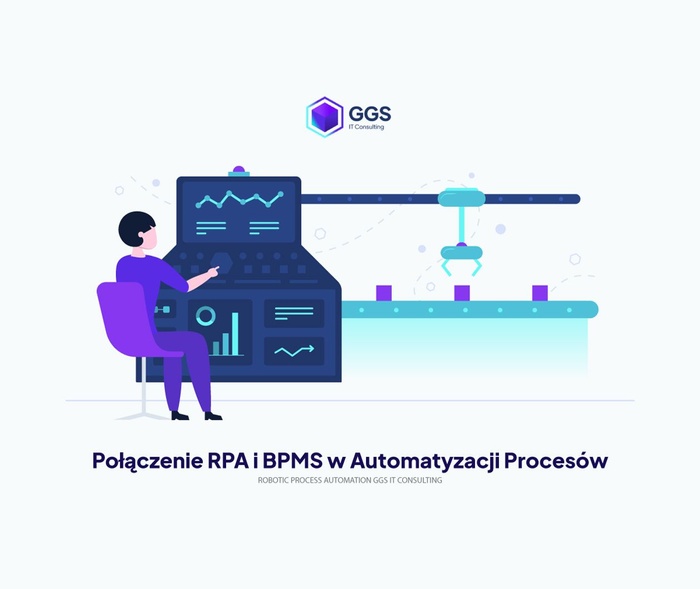Business Process AutomationLearn more
Robotic Process Automation (RPA) and Business Process Management (BPMS) – why you need to combine them.

Many companies, especially those who are new to business process automation, wonder whether to focus on Robotic Process Automation (RPA) or perhaps implementing a workflow platform (BPMS). As a result, when they decide on one of these technologies and use it, they want it to handle as many processes as possible. The thinking behind it is: since we are investing in Robotic Process Automation, we should automate all the processes in our company. Is this approach right? More in this article, but first just a quick look at RPA and BPM.
What is Robotic Process Automation (RPA)?
Gartner defines Robotic Process Automation (RPA) as a productivity toolkit that allows configuring applications, called software robots, to carry out tasks or entire business processes as a human would. This applies to repetitive and structured tasks such as data transfer or data movement from/to and between applications. This is usually done at the GUI level, or the desktop of your computer and with the applications that run on that computer.
What is Business Process Management (BPM)?
Business Process Management is a set of activities that support the management of business processes in organisations. It covers the area of identification, analysis, design, optimisation and automation of business processes. Business Process Management (BPMS) platforms are used to facilitate the conduct and management of these activities. Such platforms most often include capabilities related to:
- graphical modelling of business processes
- easy development of applications corresponding to processes
- creating workflows for applications.
“How about we automate the process a bit more?”
We very often hear this question from customers who are newcomers to business process automation. This question often relates processes that are indeed awkward for the organisation, and their automation is possible, but at the same time it is not the best way to automate them. This is part of the “since we are investing in robots, let's use them in as many processes as possible” thinking.
“Since we are investing in robots, let's use them in as many processes as possible.”
This approach means that Robotic Process Automation ends up failing to deliver the expected returns on investment. But this is not because the tool itself is bad, but it is used for processes for which it was not intended. It is a bit like saying that if we have a fleet of Opel Astras, let’s use them to deliver cargo to our customers. It can be done, sure, but is it be the most efficient way?

So how do you approach process automation in your company?
Above all, let’s not start a process automation project by choosing your tools. Let's first identify the processes, find an inside person who understands them and is able to act as an interface between the technology and the business objectives to be achieved through automation. Only then can we begin to consider what tools will help us do this. This will help us determine whether our goods should be carried in a van or perhaps an Opel fleet.
It will then be much easier to decide which processes and tasks are more suited to Robotic Process Automation and which should be approached with other tools, such as BPMS. Certainly, however, there will be room for both of these technologies in most organisations.
By combining RPA and BPM we will achieve the best results.
In fact, it is very difficult to plan how we would ultimately like our perfectly automated company to look like. This is because automating processes in a company is also a process, and processes must be learned and constantly improved to fit our business environment. Being aware of this will allow us to look at automation from different perspectives and in the context of different technologies.
So what benefits will the various RPAs and BPMs bring together?
1. Exception management
When the RPA robot encounters a case for which it is not programmed, it will require human intervention through manual verification. BPM streamlines this process by clearly defining how exceptions are handled and monitored. This increases productivity, ensuring that processes continue to move forward.
2. Acceptances in decision-making processes
Not all decisions in acceptance processes can be automated. RPA robots can automatically make minor business decisions, eliminating manual processes. The BPM platform can be responsible for acceptance procedures in relevant processes or cases and handling the routing of such decisions to relevant stakeholders. Example: In the order-to-pay process for orders up to x amount, the robot accepts all requests if they meet the requirements. If the order value exceeds x, the acceptance path goes through the BPM system.
3. Integration with legacy applications
It is often the case that a company uses an application that does not offer the possibility of integration with a BPM platform, but this integration would be important for process automation reasons. In such a situation, the process can be carried out within the BPM platform and the programmable robot would take care of the information exchange between the BPM platform and the application.
4. Elimination of bottlenecks
A bottleneck in many BPM-controlled processes is the need to manually supply it with information. Manual input of such information also creates the possibility of errors. Moreover, the process of entering this information itself can be a significant part of the overall process. It is therefore a good idea to consider using an RPA bot to enter data into the BPM system. A case in point is the use of an OCR robot, which will enter data from invoices into the invoice-handling system based on a BPM platform.
Summary
When approaching the implementation of business process automation projects, it is a good idea to start by looking at your company's processes separately from the technology. It is a good idea to consider what business objectives this automation is intended to meet. Only then should we relate this to technology and find someone within or outside the company to look at these processes through in the context of these specific objectives rather through IT solutions.
If you are wondering how to approach this issue in your company, one option is to take advantage of our free-of-charge consultation where our consultant will meet your for a 30-minute teleconference to suggest what is best thing to do in your individual situation. You can make an appointment for a consultation here.
